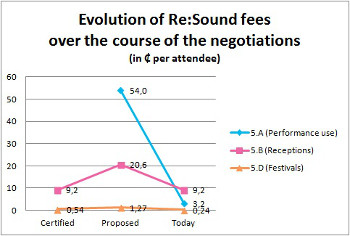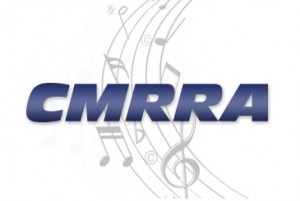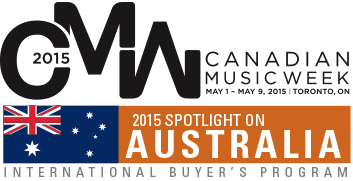CAPACOA is proud to announce that we have reached an agreement in principle with Re:Sound.
This agreement is the conclusion of two years of constructive negotiations on a series of tariffs for the use of recorded music that had been submitted to the Copyright Board for certification by Re:Sound in 2012 (see the historic overview for more details).
“We are very pleased with the co-operative nature of our relationship with Re:Sound as well as with the outcomes of our negotiations,” declared Paul Gravett, CAPACOA president. “We now have simplified, more affordable, tariffs that are respectful of both performing arts presenters and right holders.”
 |
| Note: These estimated fees were calculated using actual figures from CAPACOA members. They may not be reflective of the actual fees in the Settlement Tariffs. |
The agreement, which is still subject to the final approval of the boards of directors of CAPACOA and Re:Sound, includes a series of Settlement Tariffs, to be filed with the Copyright Board for certification. Among these are a revised, more flexible, Tariff 5.A for music accompanying live entertainment, as well as a simplified and standardized Tariff 5.D for festivals, exhibitions and fairs. The chart that follows provides a comparative of selected tariffs as currently certified, as proposed by Re:Sound in 2012, and as they will be experienced by CAPACOA members in 2015 (it should be noted that these estimated fees were calculated using actual figures from CAPACOA members and, as such, they may not be reflective of the actual fees in the Settlement Tariffs).
The agreement also includes provisions pertaining to the payment of licenses for past periods by CAPACOA members as well as members of affiliate presenting networks. These provisions will be communicated to members in a series of private webinars on January 29 and February 2, 3, 5. Because of time constraints in the delivery of these webinars, members won’t be required to remit licences for the 2014 calendar year until after the webinar series.
CAPACOA would like to thank Re:Sound for its collaboration over the course of the negotiations. We would also like to acknowledge the collaboration of other performing arts objectors – Sony Centre for the Performing Arts, Roy Thompson and Massey Hall, National Arts Centre, La Place des Arts, Royal Conservatory of Music, Professional Association of Canadian Theatres – and of the Canadian Association of Fairs and Exhibitions.
Historic Overview
For many years Canadian composers and authors have received royalties from the broadcast and public performance of their compositions. These royalties are collected by SOCAN. In 1997 the Copyright Act of Canada was amended to acknowledge the essential contribution of artists (including feature performers, background musicians, etc.) and record companies in the creation of recorded music, and to add a right to equitable remuneration for artists and record companies, which is in line with similar rights in the rest of the world. This right to equitable remuneration is sometimes also called a “neighbouring right”.
Created in 1997 (originally as NRCC), Re:Sound is the Canadian not-for-profit music licensing company mandated by its members to license recorded music for public performance, broadcast and new media.
Tariff 3 (Background music) was one of the first tariffs certified by the Copyright Board of Canada to Re:Sound in 2006. In 2008, Re:Sound submitted a series of live event tariffs to the Copyright Board. Tariffs 5.A-G (Use of Recorded Music to Accompany Live Events, 2008-2012) were certified in May 2012 and became payable by performing arts organizations back to 2008.
In summer and fall 2012, when Re:Sound started collecting royalties under these tariffs, many performing arts organizations were unprepared and turned to CAPACOA for advice and support. In response, CAPACOA agreed with Re:Sound that all member communication would be channelled through CAPACOA until further negotiations had taken place.
In the same year, Re:Sound filed these tariffs for renewal and submitted new tariffs for certification to the Copyright Board. However, the royalty rates for these tariffs were considered too high and several provisions seemed unfair to CAPACOA members. CAPACOA therefore joined a group of performing arts organizations to file an objection to the Copyright Board on proposed tariffs 3, 5 (parts A, D, E, I and J) and 6.A.
In May 2013, CAPACOA renewed its efforts with the assistance of attorney Mark Hayes. In August, CAPACOA submitted a series of observations and proposals to Re:Sound, including a request to reduce the number of tariffs and new wording for Tariff 5.A to account for all use of recorded music as part of a live performance. Re:Sound responded in late December 2013, indicating that they were in agreement with several of our recommendations and provided reassurance they would not move forward with their proposed fee increases.
In 2014, CAPACOA intensified consultations with members, arts service organizations, and other objectors. This included aligning our position with the Canadian Associations of Fairs and Exhibitions (CAFE), an objector to the Tariff 5.D (Festivals, Exhibitions and Fairs) and with Festivals and Major Events. After much analysis and negotiations, Re:Sound agreed in November 2014 to amend Tariff 5.D as proposed by CAPACOA and CAFE in order to address inequities in the fee structure.
Today’s settlement agreement resolves most of the issues that CAPACOA and other objectors initially raised in 2012 and 2013. There remains a few outstanding issues that couldn’t be resolved because of prior agreements between Re:Sound and other objectors. Among other issues, further tariff consolidation will be sought in 2015. The constructive relationship between CAPACOA and Re:Sound will certainly be an asset for this next chapter.













